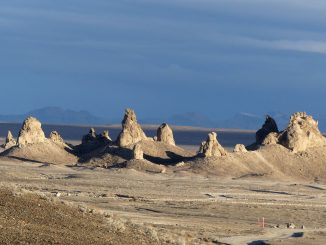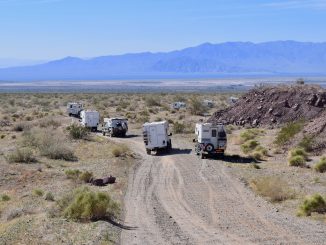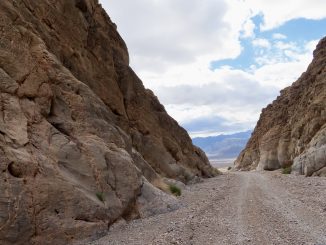
Death Valley National Park is a must-see attraction for today’s truck camper adventurer. Within the national park’s more than 3 million acres you find a number a number of attractions including dozens of abandoned mines as well as old mining cabins adopted by caring groups to preserve the mining history of the area. One of the best of these is the Corona Mine located at the end of the Jail Canyon 4×4 trail.
Located in the Panamint mountains, the Corona Mine is a worthy day-trip destination that should not be missed during your visit of the park. The mine is reached by taking the Jail Canyon 4×4 trail which in some areas can be very rough. An old miner’s cabin lies at the end of this road in a ravine with some aging cottonwood trees. There are a couple of flat areas where you can boondock that offer great views of the canyon below. As a matter of fact, Death Valley National Park is the only national park that allows dispersed camping. But beware. The wind can howl up the canyon with strong gusts, rocking your camper while sleeping overnight.
A guest book in the minor’s cabin shows signatures from visitors from all over the world. The adopted cabin has been maintained to arrest decay so others can experience this mining piece of history. Thankfully, groups of off-roaders have adopted many of the cabins in the area, thus preserving history for all to enjoy. A picnic table next to the cabin offers a lovely spot where you can rest and fuel-up before hiking the area.

A wood framed privy sits near one of the walking trails. Years ago we visited when the outhouse was painted blue with puffy clouds and the inside sported a hand carved rattlesnake for the toilet paper holder. You could open the door to see down the canyon while doing your business. Sadly, the little privy must have lost its caretaker. On our last visit the door was partially off its hinges and the unique carved rattlesnake was gone (hopefully not stolen). Speaking of rattlesnakes, always check the area around old outhouses for rattlers, scorpions, and black widow spiders before venturing inside.
From the cabin there are several hiking trails to the mining areas. You can walk along a willow-lined stream to go further up the canyon to see wood trams, rails, a steam boiler and other mining equipment left behind as ghosts last known as the Corona Mine. Carry water as it is easy to lose track of time while exploring, and the canyon gets steep and hot with little shade.
Mining history
The Corona Mine has had several names since 1899. In its heyday, the mine produced gold, silver, lead and copper. At one time a three-stamp mill was operated with a water wheel powered by the spring. This was destroyed by a flash flood according to author Roger Mitchell who wrote one of our favorite guidebooks, Death Valley SUV Trails.




Mines of every kind from sulfur and talc to silver and gold, litter the more than 3 million acres that comprise the Death Valley National Park. Many of the mines were successful in creating boom towns, while others were simply a ruse to make money from eager investors. Ghost towns now lie where mines went bust and were abandoned. Death Valley Scotty was one of the most colorful characters who told tales of his secret gold mine in the vicinity of Scotty’s Castle.
“A mine is a hole in the ground. The discoverer of it is a natural liar. The hole in the ground and the liar combine and issue shares and trap fools”.—Detroit Free Press 1881
How to get to Jail Canyon
Access to Jail Canyon is through a rough 4WD route from the northern end of Indian Ranch Road (graded gravel) on the west side of the Panamint Range, not far from the ghost town of Ballarat. The canyon is approximately 5.2 miles one way from Indian Ranch Road (the first 1.5 miles of the Jail Canyon Rd is located on BLM land). Access Indian Ranch Road from the Trona Wildrose Road (paved) from the south which becomes Panamint Road from the north (check out our recent TCA article on the nearby Trona Pinnacles). This road runs between the Argus and Panamint Ranges. Jail Canyon is located inside the Death Valley National Park boundary.
Note that no services exist along these roads for many miles and there is no cell phone service. Help may be many hours away; travel prepared to self-rescue. Visitors entering the park on a dirt road can pay the entry fee in advance on Recreation.gov and display a printed pass on their vehicle dashboard.

Get a guidebook or map of Death Valley National Park for more detailed directions. I like the National Geographic or Tom Harrison Death Valley map that can be purchased online or at the park’s visitor center.
Most visitors give the Jail Canyon 4×4 road a “Moderate” rating. Although most of the road is fairly easy, you will have to climb in and out of a wash and negotiate some rocks once you are deep in the canyon, meaning you may have to “crawl” over them. Check for current road conditions as recent rains may make this road impassable. A huge boulder much bigger than our truck was laying alongside the trail the last time we visited. This road is best suited to short wheelbase, high clearance 4×4 trucks and lightweight campers (small hard-side campers and pop-ups). We also took our Jeep Wrangler to tackle more challenging trails on our trip.
















Be the first to comment